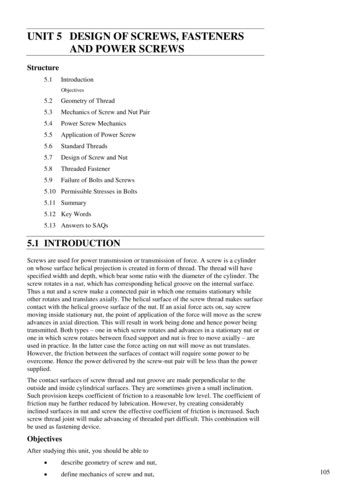
Transcription
DESIGN GUIDEFOR STEAM TRACING APPLICATIONSTHERMON The Heat Tracing Specialists
Design GuideFor Steam Tracing ApplicationsIntroduction. 2Application Information. 2Steam Tracing Design Outline. 3Basis for a Good DesignStep 1: Establish Design Parameters. 3Step 2: Select Steam Tracing Method. 4Step 3: Identify Base Maintain Temperature. 4-12Step 4: Apply Any Adjustment Factors. 13-14Step 5: Determine Steam Tracing Circuit Lengths. 15-16Step 6: Choose Options/Accessories. 16-17Design Tips. 18Tables: Properties of Saturated Steam. 19-20For additional information about steam tracing, please refer to the Steam TracingSpecification Guide (Thermon Form TSP0010) or contact Thermon.1
Design GuideFor Steam Tracing ApplicationsIntroduction . . .All too often an old steam tracing specification or previously adopted practices are followed which overlooknew product developments or improvements. Todaythere are more types of steam tracers to choose fromthan ever before, providing a range of conductances toclosely match the actual heat requirements for a givenpipe heating system. By maximizing performance witha range of steam tracers while minimizing the total costof unnecessary components, the cost of ownership for asteam tracing system is optimized.This design guide addresses the steam tracing requirements of piping and equipment by matching the heatingrequirements with the type of steam tracers best suitedfor that application. The information contained in thisdesign guide will take the reader through a step-by-stepprocedure to make proper steam tracer selections basedon: Pipe size Thermal insulation type and thickness Desired maintain temperature range Maximum exposure temperature limitations Minimum ambient temperatureAfter following the prescribed steps in this design guide,the reader will be able to design, select and/or specify orestablish a bill of materials for a steam tracing system.For applications ranging from freeze protecting waterlines to maintaining elevated process temperatures ashigh as 1,250 F (677 C), Thermon has a tracing productto fit the application. These product families are distinctlybroken down into three groups: isolated tracers, bareconvection tracers and conduction tracers.Isolated Tracers . . . Designed for use with low to medium-low heat requirements, Thermon’s SafeTraceTM SLSIT and DLS-IT are metallictracer tubes covered withcomposite materials thatlower thermal conductanceto reduce heat output andtemperature. The reducedheat output of SafeTraceSLS-IT and DLS-IT ispredictable to ensure controlled heat distributionalong the length of a traced pipe without hot spots oroverheating. These tracers also utilize a safety yellowidentification jacket to signify the presence of inherentlydangerous materials such as steam. A feature unique toSafeTrace SLS-IT and DLS-IT is their ability to run con2tinuously from the steam supply manifold, along the pipeand to the condensate return manifold.Convection Tracers . . . By using bare tracers orSafeTrace BTS tracers, convection tracing providesmedium-low to medium heat transfer requirements.SafeTrace BTS is a metallic tracer tube covered witha special high temperature polymer jacket thatprovides a meas-ure ofpersonnel burn protectionwithout sacrificing thermalperformance. The safetyyellow jacket also providescorrosion resistance tomost acids and alkalis.Conduction Tracers . . . When the heat requirementsexceed the capabilities of isolated and convection tracers, tracers aided by heat transfer compounds shouldbe used. Thermon’s heat transfer compounds, availablein a wide variety of configurations to meet the application requirements, provide excellent heat transfer at afraction of the cost of ajacketed pipe system whileeliminating the possibilityof product contamination.The heat transfer properties of Thermon’s compounds are so good that asingle tracer utilizing heattransfer compound will dothe work of three to five bare tracers.Computer-Aided Design Program . . .Thermon has developed a sophisticated yet easy-to-usecomputer program, CompuTrace , that provides detaileddesign and performance information. Users of CompuTrace are able to input application-specific informationinto the program and obtain detailed performance information. Calculations made within the program are basedon universally accepted process heat transfer equations.The information input to and/or generated from CompuTrace can be printed and summary reports, including“condensate load” information, exported for use in otherprograms. While CompuTrace is a valuable asset to usein designing a steam tracing system, the design stepsdetailed in this guide will still form the basis for identifying the design process necessary to establish a properlyfunctioning steam tracing system.
THERMON The Heat Tracing Specialists Steam Tracing Design Outline . . .Basis for a Good Design . . .The six steps below outline the design and selection process for a steam tracing system. The step-by-step procedures that follow the outline will provide the reader withthe detailed information required to design, select and/orspecify a fully functional steam tracing system.Every steam tracing design will involve six design factorsof which three are given (fixed) and three are variable.The given factors are: nominal pipe size, desired maintain temperature and low ambient temperature. Thevariable factors are: tracer type, size and number; steampressure (temperature); and insulation type and thickness. Establishing a balance amongst the variable factors will provide maintain temperatures within the desiredrange. Conversely, should any of the variable factorsdeviate, the balance will be upset and the temperaturecould be outside of the desired range.Step 1: Establish Design ParametersCollect relevant project data:a. Piping/equipment Diameter–lengthb. Temperature Low ambient Maintain temperature High temperature–limits/excursionsc. Insulation Type–thickness–oversized?d. Availability of steam Pressure LocationStep 2: Select the Proper Thermon Steam TracingMethodUsing information gathered in Step 1 and basedon:a. General selection tablesb. CompuTrace computer design programStep 3: Identify Base Maintain TemperatureUsing supplied tables and based on:a. Pipe sizeb. Insulation thicknessc. Steam pressured. Tracer type and quantityStep 4: Apply Any Adjustment FactorsBased on:a. Different low ambient temperaturesb. Different thermal insulation typesStep 5: Determine Steam Tracing Circuit LengthsBased on:a. Steam pressureb. Quantity of tracersc. Tracer tubing diameterd. Adjustments for accumulated vertical tracerrise, elbows and bendsStep 6: Choose Options/AccessoriesBased on:a. Tracer typeb. Attachment methodTo become familiar with the requirements of a properlydesigned steam tracing system, use the six design stepsdetailed here and on the following pages. Once comfortable with the steps and the information required, applythese steps to any size steam tracing project.Step 1:Establish Design ParametersCollect information relative to the following design parameters:Application Information . . . Pipe sizes Pipe lengths Type and number of valves, pumps or other equipment Type and number of pipe supportsExpected Minimum Ambient Temperature . . . Generally, this number is obtained from weather data compiledfor an area and is based on recorded historical data.There are times, however, when the minimum ambientwill not be the outside air temperature. Examples includepipes and equipment located underground or insidebuildings.Desired Maintain Temperature . . . While the desiredtemperature might be a specific value, there will usuallyexist a temperature range where the product can effectively exist without any damage or upset. Any temperature extreme that could result in product or equipmentdamage should be noted to ensure this point is notreached.Insulation Material and Thickness . . . While the typeand thickness of insulation should be a variable in thedesign equation, there are times where a plant specification dictates a specific insulation standard. The selectioncharts in this design guide are based on calcium silicateinsulation with thicknesses as shown in the various tables. If insulation materials other than calcium silicateare used, refer to the insulation correction factors shownin Table 4.2 or contact Thermon or a Thermon factoryrepresentative for design assistance.3
Design GuideFor Steam Tracing ApplicationsStep 2: Select the Proper Thermon Steam TracingMethodFor a steam tracing system to perform at optimal levels,choose the type of tracer that most closely meets theprocess design requirements using Table 2.1 below.Table 2.1 Process Temperature vs. Tracer TypeProcess Temperature RangeTracer TypeLOW50 -100 F (10 -38 C)IsolatedMEDIUM-LOW101 -150 F (39 -66 C)Isolated/ConvectionMEDIUM151 -200 F (67 -93 C)Convection/ConductionMEDIUM-HIGH201 -300 F (94 -149 C)ConductionHIGH301 -400 F (150 -204 C)ConductionProper selection will avoid the effects of overheating andconserve energy. Where possible use only one tracerper process pipe (certain critical process lines may require a redundant heater). This will reduce the number oftrap stations, isolation valves and fittings required whileeliminating future maintenance on omitted materials.After determining the tracer type, use Table 2.2 to establish the proper insulation thickness based on the temperature range to be maintained for a given nominal pipesize1.Table 2.2 Typical Insulation ThicknessTemperature RangesPipe Sizein(mm) 50 -100 F 101 -150 F 151 -200 F 201 -300 F 301 -400 F(10 -38 C) (39 -66 C) (67 -93 C) (94 -149 C) (150 -204 C)1½ 1½ (40)1½ (40)1½ (40)1½(40)6(150)1(25)1½ (40)1½ (40)1½ (40)8(200) 1½ (40)1½ (40)1½ (40)10 (250) 1½ (40)1½ (40)212 (300) 1½ (40)1½ (40)14 (350) 1½ (40)1½ 50)2(50)2½(64)216 (400) 1½ (40)2(50)2(50)(50)2½(64)18 (450) 1½ (40)2(50)2(50)2½ (64)2½(64)20 (500)2(50)2(50)2(50)2½ (64)2½(64)24 (600)2(50)2(50)2½ (50)2½ (64)3(64)30 (750)2(50)2(50)2½ (50)2½ (64)3(75)To obtain more accurate design results and view whateffects changing any of the variable inputs may haveon the maintenance temperature, use Thermon’s CompuTrace computer-aided design and selection softwareprogram. Available on request from Thermon or a Thermon factory representative, this program provides accurate steam tracing performance data and load chartinformation that can be exported.Step 3: Identify Base Maintain TemperatureApply the fixed design factors established in Step 1 andthe variable design factors selected in Step 2 to Tables3.1 through 3.8 (see below for determining which tableto use). Each table is divided based on tracer type withrows denoting the nominal pipe diameter and columnsdenoting steam pressure (temperature) and number oftracers. All of the tables are based on a minimum ambient temperature of 0 F (-18 C) and wind speeds of 25mph (11 m/s).Process Temperature Maintenance (Inch-Pound System)Tracer TypeSteam PressureTableBare/BTS & Isolated15, 30, 50 & 75 psig3.1Bare/BTS & Isolated100, 150, 200 & 250 psig3.2Heat Transfer Compound15, 30, 50 & 75 psig3.3Heat Transfer Compound100, 150, 200 & 250 psig3.4Process Temperature Maintenance (SI System)Tracer TypeSteam PressureTableBare/BTS & Isolated205, 308, 446 & 618 kPa3.5Bare/BTS & Isolated791, 1136, 1480 & 1825 kPa 3.6Heat Transfer Compound205, 308, 446 & 618 kPa3.7Heat Transfer Compound791, 1136, 1480 & 1825 kPa 3.8Example . . . A process line requires steam tracing. Theparticulars for the line are:Pipe diameter. 10"Design process temperature.250 FInsulation thickness. 2"Steam pressure (temperature).100 psig (338 F)Minimum ambient/wind speed.0 F/25 mphTable 2.1 identifies the application as a “Medium-High”temperature category and indicates the need for a conduction heater using heat transfer compound. Table 2.2identifies that for a 10" diameter pipe maintaining 250 F,2" thick insulation is needed. Based on these factors,use Table 3.4 to determine that one 3/8" or 1/2" diametertube tracer with heat transfer compound will provide thedesired maintain temperature.Note . . .41. Table is based on calcium silicate insulation oversized by one nominal pipesize to accommodate tracer. Refer to Table 4.2 for details on using other insulation materials.
THERMON The Heat Tracing Specialists Table 3.1 Process Temperature Maintenance ( F) . IT, BT or BTS TracersAmbient Temperature: 0 F, Wind: 25 mph, Insulation: Calcium SilicatePipeSizein1½234681012141618202430Steam PressureInsulation15psig250 F30psig274 F50 psig 298 F75 psig 320 S-ITSLS-ITBTorBTSDLS-ITSLS-IT BT or BTSinIsolated IsolatedBareIsolated IsolatedBareIsolated IsolatedBareIsolated 7128310
steam tracing system is optimized. This design guide addresses the steam tracing require-ments of piping and equipment by matching the heating requirements with the type of steam tracers best suited for that application. The information contained in this design guide will take the reader through a step-by-stepFile Size: 1MBPage Count: 23Explore furtherSteam Trace Heatingwww.heatingandprocess.comSTEAM TRACER LINE APPLICATIONSwww.armstronginternational.comLogin - PIPpip.orgBest Way to Insulate Steam Pipeswww.thermaxxjackets.comRecommended to you based on what's popular Feedback











